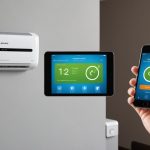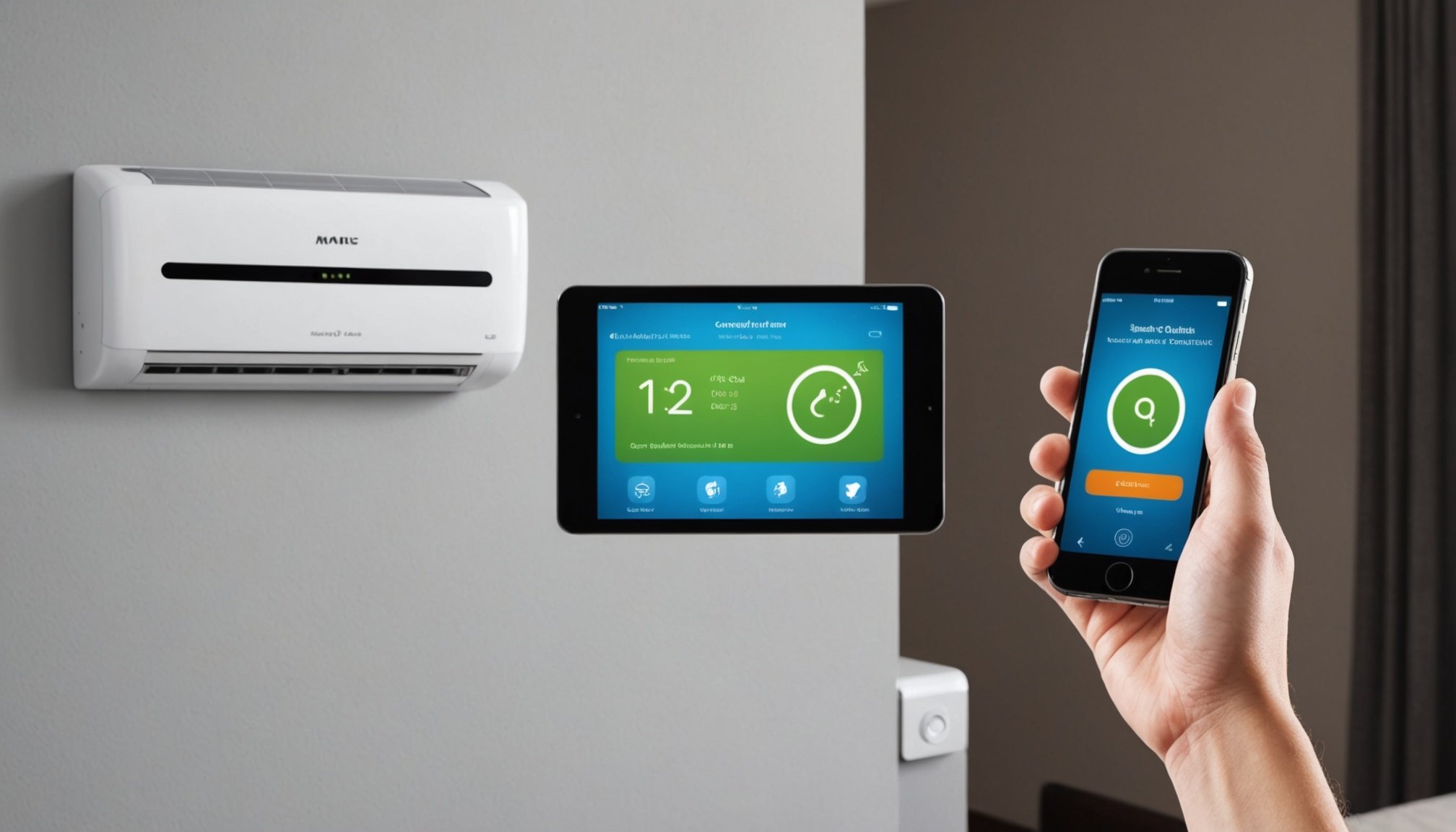Mastering Smart Home Comfort: Your Guide to Managing Air Conditioning Units with Your Smartphone
In the era of smart home technology, managing your air conditioning units has never been more convenient or energy-efficient. With the ability to control your HVAC systems from your smartphone, you can ensure optimal comfort and reduce your energy consumption. Here’s a comprehensive guide to help you master smart home comfort.
Understanding Smart Thermostats and Their Benefits
Smart thermostats are at the heart of modern HVAC systems, offering a plethora of features that enhance both convenience and energy efficiency. Here are some key benefits of using smart thermostats:
Also to discover : Crafting and Sharing Engaging Travel Itineraries: Your Ultimate Guide to Smartphone Magic
Enhanced Convenience
Smart thermostats allow you to adjust the temperature in your home from anywhere, using your smartphone. This means you can ensure your home is at the perfect temperature when you arrive, whether you’re coming home from work or returning from a vacation.
Energy Efficiency
One of the most significant advantages of smart thermostats is their ability to optimize energy usage. With features like geo-fencing, these devices can detect when you are not home and adjust the temperature accordingly, saving you money on your energy bills. For example, setting your thermostat to 78 degrees when you are at home and 85 degrees when you are away can make a substantial difference in your energy consumption.
Also read : Mastering Real-Time Traffic Alerts: Unlock Your Smartphone”s Potential for Instant Updates!
AI Integration
Some smart thermostats come with AI integration, which allows them to learn your preferred temperature settings and adjust them intuitively. This not only enhances comfort but also ensures that your HVAC system operates efficiently.
Choosing the Right Smart Thermostat for Your Home
With so many smart thermostats available on the market, choosing the right one can be daunting. Here are some factors to consider and a comparison table to help you make an informed decision.
Key Features to Consider
- Compatibility: Ensure the thermostat is compatible with your HVAC system and any other smart devices in your home.
- Remote Access: Look for thermostats that offer robust remote access capabilities through smartphone apps.
- Energy Reporting: Opt for thermostats that provide detailed energy usage reports to help you optimize your energy consumption.
- Voice Control: Consider thermostats that are compatible with voice-activated systems like Amazon Alexa or Google Assistant.
Comparison Table: Popular Smart Thermostats
| Thermostat Model | Compatibility | Remote Access | Energy Reporting | Voice Control |
|---|---|---|---|---|
| Nest Learning Thermostat | Most HVAC systems | Yes | Yes | Yes |
| Ecobee SmartThermostat | Most HVAC systems | Yes | Yes | Yes |
| Honeywell Home T9 | Most HVAC systems | Yes | Yes | Yes |
| Sensi Smart Thermostat | Most HVAC systems | Yes | Yes | Yes |
Installing and Setting Up Your Smart Thermostat
Installing a smart thermostat is generally a manageable DIY project, but it requires some care and attention to detail.
Preparing for Installation
Before you start, ensure you have the necessary tools and that the power to your HVAC system is turned off to avoid any electrical accidents. It’s also crucial to check if your new thermostat is compatible with your existing HVAC setup.
Step-by-Step Installation Guide
- Turn Off the Power: Switch off the power to your HVAC system at the circuit breaker or fuse box.
- Remove the Old Thermostat: Carefully remove the old thermostat and inspect the wiring. If the wires are not color-coded, use tape and a pen to mark them before disconnecting them.
- Install Additional Parts: If necessary, install any additional parts such as new wiring or a different faceplate.
- Connect the Wires: Connect the color-coded or marked wires to their appropriate places on the new thermostat. Ensure the connections are solid to avoid future issues.
- Mount the Thermostat: Mount the new thermostat into its faceplate and perform any necessary repair work or painting.
- Turn On the Power: Turn the power back on and test the thermostat to ensure everything is working correctly.
Optimizing Your Thermostat Settings for Energy Efficiency
Optimizing your thermostat settings is crucial for maximizing energy efficiency and comfort.
Best Practices for Thermostat Settings
- Set a Consistent Temperature: Maintain a consistent temperature when you are at home. For cooling, 78 degrees is often recommended, while for heating, 68 degrees is a good starting point.
- Use Scheduling: Use the scheduling feature to adjust the temperature when you are away or sleeping. This can significantly reduce energy consumption.
- Utilize Geo-Fencing: If your thermostat supports geo-fencing, enable it to automatically adjust the temperature when you leave or arrive home.
Example Settings for Different Scenarios
- Weekday Schedule:
- 7:00 AM: 68°F (heating) or 78°F (cooling)
- 8:00 AM: 70°F (heating) or 80°F (cooling) when you leave for work
- 5:00 PM: 68°F (heating) or 78°F (cooling) when you return home
- 10:00 PM: 65°F (heating) or 82°F (cooling) when you go to bed
- Weekend Schedule:
- Adjust the schedule to reflect your weekend activities and ensure the temperature is comfortable when you are at home.
Maintaining Your HVAC System for Optimal Performance
Regular maintenance is key to ensuring your HVAC system operates efficiently and extends its lifespan.
Common Maintenance Tasks
- Filter Replacement: Replace air filters every 1-3 months to ensure good air quality and efficient airflow.
- System Inspections: Perform annual inspections to check for any issues with the system, such as leaks or worn-out parts.
- Cleaning: Clean the outdoor unit and ensure it is free from debris and obstructions.
Benefits of Regular Maintenance
Regular maintenance can help:
- Extend System Lifespan: Proper maintenance can extend the life of your HVAC system, saving you from costly replacements.
- Improve Energy Efficiency: Well-maintained systems operate more efficiently, reducing energy consumption.
- Enhance Indoor Air Quality: Regular filter replacements and system cleaning ensure better indoor air quality.
Troubleshooting Common Issues with Smart Thermostats
Despite their advanced features, smart thermostats can sometimes malfunction. Here are some common issues and how to troubleshoot them:
Common Issues and Solutions
- Thermostat Not Turning On:
- Check if the power is turned off at the circuit breaker or fuse box.
- Ensure all connections are secure and not loose.
- Inconsistent Temperature:
- Check the thermostat settings and ensure they are set correctly.
- Verify that the thermostat is calibrated properly and that there are no issues with the HVAC system.
Integrating Smart Thermostats with Home Automation
Smart thermostats can be integrated with other smart devices in your home to create a seamless home automation experience.
Benefits of Home Automation
- Enhanced Convenience: Control multiple devices from a single interface.
- Energy Efficiency: Automate energy-saving routines across various devices.
- Improved Comfort: Ensure consistent comfort levels throughout your home.
Example of Home Automation Integration
- Smart Lighting and Thermostats: Adjust lighting and temperature settings simultaneously when you enter or leave a room.
- Voice Control: Use voice commands to control your thermostat, lights, and other smart devices.
Mastering smart home comfort with your smartphone is a powerful way to enhance your living experience while saving energy. By choosing the right smart thermostat, optimizing your settings, maintaining your HVAC system, and integrating it with home automation, you can create a comfortable, efficient, and smart home environment.
As John K., a satisfied user of smart HVAC solutions, noted: “I was able to adjust the setup and fix the problem myself thanks to the section on forced-air systems. This has not only saved me money but also given me peace of mind knowing I can manage my HVAC system independently.”
Incorporating smart thermostats and maintaining your HVAC system is a small but significant step towards a more comfortable, energy-efficient, and smart home. With the right knowledge and tools, you can ensure your home remains a haven of comfort and efficiency.











